|
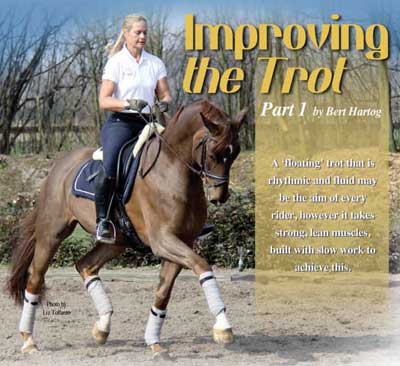
IMPROVING THE TROT
by Bert Hartog
A pace used extensively in dressage tests, the trot is the most important pace of all, and as a movement carries a higher score in tests when performed correctly.
The trot is the most important pace of all, it is a pace that is used extensively in all dressage tests but is even more important in the higher tests as movements such as the piaffe and passage, which carry a co-efficient score of three, (meaning the score for the movement, between 0-10, is trebled) are developed from the trot. In Australia many riders have Thoroughbred horses that may have a good gallop but the trot is often not as good as it should be.
Thoroughbreds are often called ‘daisy cutters’, meaning that the horse’s feet stay very low to the ground when moving forward. The breed was traditionally bred for racing however many have originated from the track to become pony club, hack, eventing, jumping or dressage horses. Although riders may sometimes be seen racing around the dressage ring just to be finished as soon as possible, it is not the gallop that needs to be worked on!
For the rider, the trot is a more difficult pace to cope with, because sitting to the trot is more difficult than the canter, and riders may often create an easier ride by not working as hard in the trot as they should. Some, who have Warmblood horses with a good trot, think they can rest on their laurels, but may be surprised to discover it is quite easy to spoil good paces, even the trot. A good rider will try to enhance what is already there, or create and improve what is not there naturally.
mechanics of the trot
When analysing how the horse moves forward in the trot, it can be seen that it is a diagonal movement. The horse moves forward with the legs in pairs left hind and right front and right hind and left front. In between the movement of the legs is a moment of suspension, and it is this that indicates if the horse has nice paces in the eyes of most people. In the suspension, the horse is off the ground with all four legs - some appear to be ‘floating’ through the air, particularly when they are excited or showing off. Of course, the ‘floating’ action indicates the quality of the horse, but for the horse to be able to ‘float’ a lot of other conditions must be met. A horse can only ‘float’ in the trot when the hind legs are so engaged (placed forward under the horse’s
centre of gravity) that they are carrying and pushing the horse upwards and forward. It must also be supple in the back and have a free shoulder movement, as a horse with a ‘jammed up’ shoulder will take short steps
and therefore cannot ‘float’.

In the analyses of the movement of the trot - the horse moves forward with a diagonal movement of the legs. When the hind leg moves forward the horse takes the hip forward as well, and the moving forward of the hip causes a bend in the spine of the horse, as can be seen in the diagram below.
It is clear from the drawing that the horse must be supple in the spine laterally (sideways) for the hind leg to have a great reach. A horse with a stiff spine is only able to move the legs without the help of the hips, which would restrict the movement of the hind legs greatly. As the hind legs move forward, with each pace the pelvis is somewhat tucked under, making the spine move upwards as well as sideways - this upward and sideways movement is called the ‘swinging’ of the back.
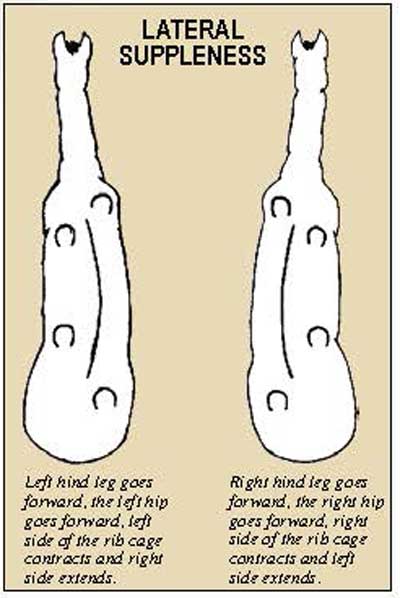
shoulders and front legs
The shoulders of the horse are not attached with any bones to the horse’s body. Their only attachments are muscles and tendons so, for the shoulders to move freely, the horse needs to have supple muscles in the rib cage and neck.
The upward bounce of the horse in trot is caused by the strength of the tendons in the legs. Freedom in the body greatly facilitates the bounce, but it is, in essence, the tendons that give the horse the spring.
With each stride the horse slowly sinks through the fetlocks and the stretching of the tendon releases a lot of energy when the foot leaves the ground. It is a little like an elastic band; when it is pulled tight by stretching, it can give quite a sting when it is let go.
It is said that the horse is a ‘tendon mover’. The tendons that run down the back of the horse’s legs are the ones that stretch when it puts its legs down and stretch even more when the horse moves the legs back.
Action and reaction
Of course the tendons at the front of the legs also stretch when the horse moves the legs backwards and cause the forward movement when the legs need to move forward. Action always causes reaction, if things are to stay in equilibrium. The theory here is that the legs cannot make a larger movement going backwards than they are going forwards.
When the horse goes relatively slowly the legs usually take larger strides than when they are going fast. The larger the strides the more stretch there will be in the tendons when the legs are back, and the greater the stretch, the greater the kick back. In other words, a larger stride will bounce the horse higher off the ground, because of the stretching of the tendons.
Tendons and muscles – going slowly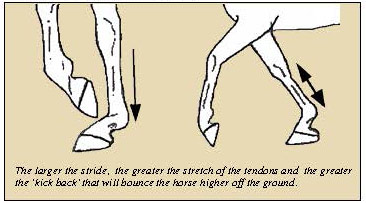
The tendons have been discussed first because of their influence on any training regime and should always be considered when starting a young horse. Instead of trotting in a fast rhythm, the rider must make a point with the young horse to go slowly, which is often easier said than done, because the young horse will find this difficult. The comparison can be made between young horses and people who do weight training. They always have to do more weights than they are used to, so that the muscles are somewhat stressed and become stronger. At first they can do the exercises comfortably with only three kilo’s, however, they are stressed with 3.5 kilograms. Eventually they will build up in strength and can lift 3.5 kilograms comfortably because the muscles have become stronger, so they move to 4 kilograms etc.
With the young horse going slowly it is at first quite an effort and the rider should only do short periods to begin with. Once the horse feels as though it is becoming comfortable with this slow movement, more impulsion may be asked for.
Some riders may complain that while they are strengthening the tendons of the horse the rest of the horse seems to be ignored. However, because the tendons are always at the end of a muscle this means that there is always a muscle involved as well - for the hind legs to move backwards a muscle in the rump must contract (become shorter). To gain strength, exercises performed in gymnastics are always performed slowly or the exercise has no value.
The Young Horse
Of course, the muscles of the young horse are underdeveloped and small at first, which is why the first part of training them always takes a long time. Once the muscles have increased in size the extra strength is gained a little easier.
The young horse, once more, can be compared with a gymnast who does flexibility training and strength training to be able to have ‘expression’ in their exercises. A vaulter may spend more time getting stronger and more supple than they spend on the horse. But the result is quite striking, even without being on a horse their posture improves. In training they may initially spend 24 hours of the 30 in the gym and only 6 vaulting on the horse. After their general physique was improved the exercises become more specific for the sport.
At first, with the young horse stronger muscles and tendons need to be created and then the rider will need to become more specific when training the horse for a particular discipline, as all disciplines have different demands on muscles and tendons.
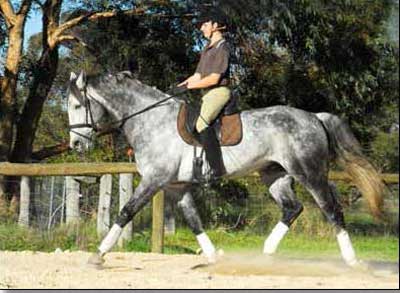
Due to the young horse’s lack of strength its stride may not be very large and requires flexibility and strength training to develop ‘expression’.
Flexibility and rhythm
Once the principles of ‘going slowly’ are understood it is possible to progress to the next principle - flexibility or suppleness of the hips and spine. Going slow has the result of the strides being larger, but not at first, as the young horse needs to become looser in the hips and spine. With the young horse’s lack of strength the strides may not be very large at first and this is the time to find the horse’s innate rhythm. Innate means the rhythm that belongs to that horse and that horse alone - every horse has a rhythm that belongs to it, and conformation and size have a lot to do with this.
The best way to identify the correct rhythm is to put the horse on the lungeing rein and look at the cantle of the saddle. When the horse is trotting with a fast rhythm the saddle hardly moves on his back, as the back of the horse is not much involved with the trot. By going slower and faster, the rhythm changes which makes the cantle of the saddle move the most is the rhythm required.
Of course, the cantle of the saddle does not move as much with the rider sitting in the saddle - or is it because the rider is holding on to their seat and back so much that they are actually preventing this movement from occurring? Many riders find it a little unsettling when the horse lets go of its back the first time, as it is a feeling that they do not recognise, and when something is not recognised, it is thought to be ‘wrong’. At first, when the horse lets go of its back it does not feel the greatest, because the horse does not know what to do with it either, and lacks strength, making it feel a little wobbly. The rider should not go against it as this letting go is what the rider wants more than anything else.
Often the horse will try to go faster or try to protect its back by keeping it rigid, and each time the rider must try to get it back by slowing down the rhythm of their seat and maintaining a relaxed lower back. By going faster the horse is trying to get out of bouncing, however this will put it on the forehand with the hind legs pushing it forward instead of carrying and pushing upwards. Most horses will try to do this with minute changes until they are going with a quicker rhythm and a flat movement, so subtly that often the rider does not even notice it! The horse may have been worked too long and be in need of a rest if the rider cannot get it to go slow again. Holding on to the back (keeping the back stiff/rigid) often goes together with an increase in rhythm, - the correction for which is described in the previous paragraph. The horse may also hold onto its back because the rider fell into the saddle a little too hard or if the rider is trying to make the horse trot better by ‘hopping up and down’ in the saddle. This will cause the horse to drop its back and stiffen it to protect it. But, more often than not, the rider actually holds onto their own back, causing the horse to stiffen up and not allowing it the freedom of movement in its back.
Over time, as the training progresses, the horse will become stronger in the tendons and muscles. It needs to develop muscle strength - but dense muscles that are not bulky - as an example the comparison of a body builder and a ballet dancer. It is difficult to imagine Arnold Schwarzenegger with his bulky muscles doing ballet, however the ballet dancer with the lean muscles is just as strong and certainly has a lot of stamina. Strength with stamina, elegance and freedom of movement without impairment from bulky muscle is what the dressage horse needs.
The rump muscles will become stronger with the slow work and, as they are attached to the long back muscles that also contract and lengthen with each stride the horse takes, these too will develop more strength. Strength will also increase for the muscles on the stomach as they help the horse move the hind legs forward and pull the pelvis under. The slow strides allow the horse to finish the stride and make long strides that become longer as the strength improves.
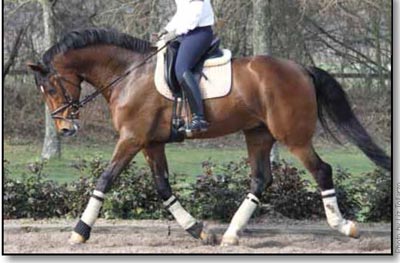
When the horse carries its head low, the back will be rounded and carried up, allowingit to take unrestricted normal strides, which it cannot do if its back is hollow.
Freedom of the shoulders
The front legs must be able to make the length of stride of the hind legs. If the hind legs of the horse have more freedom and forward energy than the shoulders do in allowing forward flow, the action of the hind legs becomes very high, making the horse look like a rooster. Overseas this is often called a ‘rooster’s gait’.
The horse also needs to let go of, or relax, the jaw and poll, so the muscles that run from the tongue to the forearm of the horse can be used freely. When it holds onto the jaw by setting it against the hands of the rider, the muscles in the neck are stiffened and the shoulders cannot move forward, as the muscles in the neck prevent them from doing so. The horse needs to carry its neck in a slight arch, which allows the bottom of the neck to hang loosely to free up the movement of the shoulders.
A low head carriage is good to involve the shoulders. When the horse carries its head low, with its neck not lower than horizontal, the back will be carried up. Compare this to someone carrying another ‘piggyback’ style on their back - they too will round their back upwards allowing them to take normal strides, which is not possible when they hollow their back. When the horse has slow strides with a low head carriage, it will be encouraged to move ‘through’ the body with involvement of the back. The horse will be able to let the shoulders take the strides with the same length as the hind legs that created them. 
Of course, there are exercises that help to supple the shoulders and to loosen the neck and these will be discussed in the second part of this series. In this article the logic of the movement of the horse in the trot and how it fits together has been covered. After all, it is important to understand how the horse moves before the rider can make improvements. The rider needs also to know how the horse should move so they have their goal of a trot with suspension, impulsion and strength clearly in sight. Every time the horse deviates from this goal the rider can take the appropriate action as they visualise clearly what the perfect picture looks like at that stage of training. |